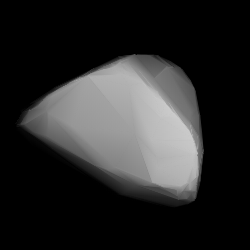Astronomy:1683 Castafiore
 Shape model of Castafiore from its lightcurve | |
| Discovery[1] | |
|---|---|
| Discovered by | S. Arend |
| Discovery site | Uccle Obs. |
| Discovery date | 19 September 1950 |
| Designations | |
| (1683) Castafiore | |
| Named after | Bianca Castafiore (fictional character)[2] |
| 1950 SL · 1936 PH 1949 HA · 1959 TH | |
| Minor planet category | main-belt · (middle)[3] |
| Orbital characteristics[1] | |
| Epoch 4 September 2017 (JD 2458000.5) | |
| Uncertainty parameter 0 | |
| Observation arc | 80.55 yr (29,420 days) |
| |{{{apsis}}}|helion}} | 3.2165 AU |
| |{{{apsis}}}|helion}} | 2.2554 AU |
| 2.7360 AU | |
| Eccentricity | 0.1756 |
| Orbital period | 4.53 yr (1,653 days) |
| Mean anomaly | 331.16° |
| Mean motion | 0° 13m 4.08s / day |
| Inclination | 12.476° |
| Longitude of ascending node | 326.66° |
| 346.87° | |
| Physical characteristics | |
| Dimensions | 18.42±0.79 km[4] 21.159±0.114[5] 21.403±0.075 km[6] 25.44 km (calculated)[3] |
| Rotation period | 13.931±0.003 h[lower-alpha 1] |
| Geometric albedo | 0.057 (assumed)[3] 0.0888±0.0159[6] 0.119±0.017[4] 0.160±0.013[5] |
| C[3] | |
| Absolute magnitude (H) | 11.6[4][6] · 11.66±0.46[7] · 11.7[1][3] |
1683 Castafiore, provisional designation 1950 SL, is a carbonaceous background asteroid from the central region of the asteroid belt, approximately 21 kilometers in diameter. It was discovered on 19 September 1950, by Belgian astronomer Sylvain Arend at Royal Observatory of Belgium in Uccle, Belgium, and named after the character Bianca Castafiore from The Adventures of Tintin.[8]
Orbit and classification
The C-type asteroid orbits the Sun in the middle main-belt at a distance of 2.3–3.2 AU once every 4 years and 6 months (1,653 days). Its orbit has an eccentricity of 0.18 and an inclination of 12° with respect to the ecliptic.[1]
Naming
This minor planet was named for Bianca Castafiore, a fictional character in the comic-strip Adventures of Tintin .[2] On the occasion of his seventy-fifth birthday, the father of the fictional character, Georges Remi, better known under his pseudonym Hergé, was honoured by the minor planet 1652 Hergé.[9] The approved naming citation was published by the Minor Planet Center on 8 April 1982 (M.P.C. 6832).[10]
Physical characteristics
Rotation period
In September 2004, American astronomer Donald P. Pray obtained a rotational lightcurve of Castafiore from photometric observations. It gave a rotation period of 13.931 hours with a brightness variation of 0.66 magnitude ({{{1}}}).[lower-alpha 1]
Diameter and albedo
According to the survey carried out by NASA's Wide-field Infrared Survey Explorer with its subsequent NEOWISE mission, Castafiore measures 21.15 kilometers in diameter and its surface has an albedo of 0.160 (best result only),[5] while the Collaborative Asteroid Lightcurve Link assumes a standard albedo for carbonaceous asteroids of 0.057, and calculates a diameter of 25.44 kilometers with an absolute magnitude of 11.7.[3]
Notes
- ↑ 1.0 1.1 Pray (2011): rotation period of 13.931±0.003 hours with an amplitude in brightness of 0.66 in magnitude. Summary figure given at Light curve Database for (1683) Castafiore
References
- ↑ 1.0 1.1 1.2 1.3 "JPL Small-Body Database Browser: 1683 Castafiore (1950 SL)". Jet Propulsion Laboratory. https://ssd.jpl.nasa.gov/sbdb.cgi?sstr=2001683. Retrieved 1 July 2017.
- ↑ 2.0 2.1 Schmadel, Lutz D. (2007). "(1683) Castafiore". Dictionary of Minor Planet Names. Springer Berlin Heidelberg. p. 134. doi:10.1007/978-3-540-29925-7_1684. ISBN 978-3-540-00238-3.
- ↑ 3.0 3.1 3.2 3.3 3.4 3.5 "LCDB Data for (1683) Castafiore". Asteroid Lightcurve Database (LCDB). http://www.minorplanet.info/PHP/generateOneAsteroidInfo.php?AstInfo=1683%7CCastafiore. Retrieved 22 December 2016.
- ↑ 4.0 4.1 4.2 Masiero, Joseph R.; Mainzer, A. K.; Grav, T.; Bauer, J. M.; Cutri, R. M.; Nugent, C. et al. (November 2012). "Preliminary Analysis of WISE/NEOWISE 3-Band Cryogenic and Post-cryogenic Observations of Main Belt Asteroids". The Astrophysical Journal Letters 759 (1): 5. doi:10.1088/2041-8205/759/1/L8. Bibcode: 2012ApJ...759L...8M. http://adsabs.harvard.edu/cgi-bin/bib_query?bibcode=2012ApJ...759L...8M. Retrieved 22 December 2016.
- ↑ 5.0 5.1 5.2 Masiero, Joseph R.; Grav, T.; Mainzer, A. K.; Nugent, C. R.; Bauer, J. M.; Stevenson, R. et al. (August 2014). "Main-belt Asteroids with WISE/NEOWISE: Near-infrared Albedos". The Astrophysical Journal 791 (2): 11. doi:10.1088/0004-637X/791/2/121. Bibcode: 2014ApJ...791..121M. http://adsabs.harvard.edu/cgi-bin/bib_query?bibcode=2014ApJ...791..121M. Retrieved 22 December 2016.
- ↑ 6.0 6.1 6.2 Mainzer, A.; Grav, T.; Masiero, J.; Hand, E.; Bauer, J.; Tholen, D. et al. (November 2011). "NEOWISE Studies of Spectrophotometrically Classified Asteroids: Preliminary Results". The Astrophysical Journal 741 (2): 25. doi:10.1088/0004-637X/741/2/90. Bibcode: 2011ApJ...741...90M.
- ↑ Veres, Peter; Jedicke, Robert; Fitzsimmons, Alan; Denneau, Larry; Granvik, Mikael; Bolin, Bryce et al. (November 2015). "Absolute magnitudes and slope parameters for 250,000 asteroids observed by Pan-STARRS PS1 - Preliminary results". Icarus 261: 34–47. doi:10.1016/j.icarus.2015.08.007. Bibcode: 2015Icar..261...34V. http://adsabs.harvard.edu/cgi-bin/bib_query?bibcode=2015Icar..261...34V. Retrieved 22 December 2016.
- ↑ "1683 Castafiore (1950 SL)". Minor Planet Center. https://www.minorplanetcenter.net/db_search/show_object?object_id=1683. Retrieved 22 December 2016.
- ↑ Schmadel, Lutz D. (2007). "(1652) Hergé". Dictionary of Minor Planet Names. Springer Berlin Heidelberg. p. 131. doi:10.1007/978-3-540-29925-7_1653. ISBN 978-3-540-00238-3.
- ↑ "MPC/MPO/MPS Archive". Minor Planet Center. https://www.minorplanetcenter.net/iau/ECS/MPCArchive/MPCArchive_TBL.html. Retrieved 22 December 2016.
External links
- Asteroid Lightcurve Database (LCDB), query form (info )
- Dictionary of Minor Planet Names, Google books
- Asteroids and comets rotation curves, CdR – Observatoire de Genève, Raoul Behrend
- Discovery Circumstances: Numbered Minor Planets (1)-(5000) – Minor Planet Center
- 1683 Castafiore at AstDyS-2, Asteroids—Dynamic Site
- 1683 Castafiore at the JPL Small-Body Database
 |

